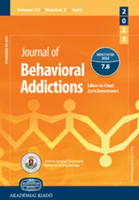Opposing associations of Internet Use Disorder symptom domains with structural and functional organization of the striatum: A dimensional neuroimaging approach
Opposing associations of Internet Use Disorder symptom domains with structural and functional organization of the striatum: A dimensional neuroimaging approach
Author(s): Fangwen Yu, Jialin Li, Lei Xu, Xiaoxiao Zheng, Meina Fu, Keshuang Li, Shuxia Yao, Keith M. Kendrick, Christian Montag, Benjamin BeckerSubject(s): Media studies, Social psychology and group interaction, Cognitive Psychology, Personality Psychology, Behaviorism, Social Informatics
Published by: Akadémiai Kiadó
Keywords: internet use disorder; internet gaming disorder; neuroimaging; striatum; hippocampus; brain;
Summary/Abstract: Background: Accumulating evidence suggests brain structural and functional alterations in Internet Use Disorder (IUD). However, conclusions are strongly limited due to the retrospective case-control design of the studies, small samples, and the focus on general rather than symptom-specific approaches. Methods: We here employed a dimensional multi-methodical MRI-neuroimaging design in a final sample of n 5 203 subjects to examine associations between levels of IUD and its symptom-dimensions (loss of control/time management, craving/social problems) with brain structure, resting state and taskbased (pain empathy, affective go/no-go) brain function. Results: Although the present sample covered the entire range of IUD, including normal, problematic as well as pathological levels, general IUD symptom load was not associated with brain structural or functional alterations. However, the symptom-dimensions exhibited opposing associations with the intrinsic and structural organization of the brain, such that loss of control/time management exhibited negative associations with intrinsic striatal networks and hippocampal volume, while craving/social problems exhibited a positive association with intrinsic striatal networks and caudate volume. Conclusions: Our findings provided the first evidence for IUD symptom-domain specific associations with progressive alterations in the intrinsic structural and functional organization of the brain, particularly of striatal systems involved in reward, habitual and cognitive control processes.
Journal: Journal of Behavioral Addictions
- Issue Year: 11/2022
- Issue No: 4
- Page Range: 1068-1079
- Page Count: 12
- Language: English

